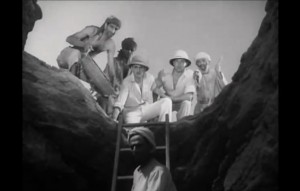(Seminar by Amanda Madden, Julia Munro, and Michael Tondre).
1.
One of the promises of teaching with digital technology involves its power to evoke the historical conditions of the past through the tools and techniques of the present. To be sure, web-based learning can be a vital means of exploring the formal and stylistic characteristics of novels, plays, poems, and other discursive artifacts. But the web can also help students to grasp the historical relations between those artifacts and the conditions of today. Such issues of history and remediation are especially pressing in my own period, the nineteenth century—an epoch that saw the widespread deployment of web-based models for society—but may have distinctive resonance for other periods of specialization, as well. Take a glance at the following essay, on teaching Henry James’s “In the Cage,” a short story that explores the newly-perceived dominance of the telegraph with equal parts anxiety and fascination. Menke writes:
Placing “In the Cage” at the media/literature interface allows us to explore it as a tale about the fears and fantasies that attend technologies of intercommunication, a subject about which our web-surfing, cell phone-using, MP3-trading students-as well as their less technologically privileged or savvy classmates-are likely to have much to say. But, as helpful as the unexpected topicality of the tale usually proves for jump-starting discussion of this somewhat verbally daunting story, a focus on questions of media in the tale can go beyond merely tapping into students’ own experiences with third-millennium communication technologies. (48)
As Menke’s essay makes clear, students might be led to think about the historical relations between the past and the present through an attention to new media–not only to reflect on their imbrication within prior technological modes and mediums, but also to inquire into the constitutive differences between the two. How can we use digital media to teach historical objects of inquiry? In what ways can we use the techniques of digital pedagogy to help students grasp the historical distance of older texts? And how can those techniques help students to see the through-lines between older media and new media, so as to enliven historical subjects and to create more vigorous, engaging class conversations? Moreover, these questions raise the issue of methodology. While these issues help us theorize the cultural impacts of technological change, how do we approach doing the history of new media? (Tondre)
2.
The following two articles, “Ethnographic Approaches to Digital Media,” and “Semiotic Ghosts: Science Fiction and Historicism,” are dense, yet provocative – particularly in regard to the latter question below:
1)How do we historicize digital media?
The theoretical and methodological apparatus for historicizing “media” seems well-established but how do we do history with digital media since the “texts” aren’t fixed?
2)What are the procedures we should use to uncover the layered history of new media?
What does doing a history of digital media entail methodologically? Can we use extant methodologies? Or does this entail reconfiguring methodologies and reframing our questions? (Madden)
3.
The topic for this week was the archaeology of digital media, with the following questions: how do we historicize media, and, what are the procedures we should use to uncover the layered history of new media?
The phrase “archaeology of digital media” struck us as rather vague. Although certain theoretical approaches (such as Freidrich Kittler’s Gramophone, Film, Typewriter, and Jay David Bolter’s and Richard Grusin’s Remediation), as did certain research approaches (archival work, both print- and digitally-based), came to mind I, at least, found myself “stuck,” for lack of a better/more eloquent word, on the word “archaeology”: I could not help but picture images from classic black-and-white mummy films of men in pith helmets raiding Egyptian tombs. My unease with the phrase suggested that, for me, a consideration of the topic, “archeology of digital media,” needs must begin with the question, why “archeology”? Why has this particular word gained currency? Why not the more general (and antecedent) phrase, “media studies”?
Perhaps the image of pith-helmeted raiders is not so far off, for as used here, archaeology metaphorically suggests an uncovering, a digging down, an excavation of media. The notion of unearthing media from the layered strata of years past is also evoked in the phrase, “a deeper examination” of media, one that’s often also used when attempting to describe this particular theoretical approach.
Although archeology metaphorically descends through layers and excavates linear time, theorists of digital media archaeology seek to distinguish the archeological approach from this very suggestion of lineage and chronology. While media studies and a History of Media may trace a seamless trajectory of progress (eliding particularities of media, technologies, practices, and context in a narrative of Communication), media archeology trace histories of media, finding not only “connections” but also “gaps” and “discontinuities,” as described in Erkki Huhtamo and Jussi Parikka’s 2011, Media Archaeology: Approaches, Applications, and Implications: “the past is brought to the present, and the present to the past; both inform and explain each other, raising questions and pointing to futures that may or may not be” (15).
Their introduction succinctly illuminates digital media archaeology as it stands at present, and was useful in my consideration of why “archaeology” of digital media. Why do you think this phrase in particular is used? How is this discipline different from historical studies, media studies, and so on? (please read pages 1-6, 13-16). (Munro)


I just came across this article and thought it was an interesting addition to Amanda’s discussion on history and digital culture:
http://www.columbiaspectator.com/2011/11/10/professor-column